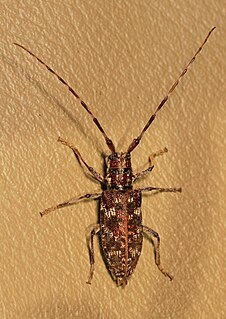
Phyllophaga is a very large genus of New World scarab beetles in the subfamily Melolonthinae. Common names for this genus and many other related genera in the subfamily Melolonthinae are May beetles, June bugs, and June beetles. They range in size from 12 to 35 mm and are blackish or reddish-brown in colour, without prominent markings, and often rather hairy ventrally. These beetles are nocturnal, coming to lights in great numbers.

Monochamus is a genus of longhorn beetles found throughout the world. They are commonly known as sawyer beetles or sawyers, as their larvae bore into dead or dying trees, especially conifers such as pines. They are the type genus of the Monochamini, a tribe in the huge long-horned beetle subfamily Lamiinae, but typically included in the Lamiini today.

Lamiini is a tribe of longhorn beetles of the subfamily Lamiinae.
Acridocephala is a genus of longhorn beetles of the subfamily Lamiinae, and the sole member of the tribe Acridocephalini, which was described by Dillon and Dillon in 1959. The genus is greatly divergent of the other Lamiini tribes of Ethiopia. The back of members heads and thoraxes and the elytra, unlike these other tribes, lie in a single plane. The front of these beetles are very narrowed forms a sharp angle with the vertex. Antenna tubercles are erect and do not diverge.

Margarinotus is a genus of clown beetles in the family Histeridae. There are at least 110 described species in Margarinotus.

Euphoria herbacea is a species of scarab beetle in Cetoniinae subfamily. It is 15–16 millimetres (0.59–0.63 in) long and is olive-green in color. It is endemic to the United States, especially to the Mississippi River.
Monochamus conradti is a species of beetle in the family Cerambycidae. It was described by Stephan von Breuning in 1961.
Monochamus accri is a species of beetle in the family Cerambycidae. It was described by Dillon and Dillon in 1959, originally under the genus Laertochamus.
Monochamus benito is a species of beetle in the family Cerambycidae. It was described by Dillon and Dillon in 1959.
Monochamus reticulatus is a species of beetle in the family Cerambycidae. It was described by Dillon and Dillon in 1959.
Monochamus thoas is a species of beetle in the family Cerambycidae. It was described by Dillon and Dillon in 1961.
Monochamus pheretes is a species of beetle in the family Cerambycidae. It was described by Dillon and Dillon in 1961.
Monochamus adamitus is a species of beetle in the family Cerambycidae. It was described by James Thomson in 1857. It is known from Tanzania, Sierra Leone, Angola, Ghana, Mozambique, the Ivory Coast, Senegal, the Democratic Republic of the Congo, Malawi, and Zimbabwe.
Monochamus griseoplagiatus is a species of beetle in the family Cerambycidae. It was described by James Thomson in 1858. It is known from Sierra Leone and Gabon.

Monochamus clamator, the spotted pine sawyer, is a species of beetle in the family Cerambycidae. It was described by John Lawrence LeConte in 1852.

Monochamus galloprovincialis, the pine sawyer beetle, also referred to as the black pine sawyer beetle, is a species of beetle in the family Cerambycidae. It was described by Olivier in 1795, originally under the genus Cerambyx. It has a wide distribution, occurring naturally throughout Europe and the Caucasus. It has also been introduced into the Canary Islands. It serves as a vector for the parasitic nematode species Bursaphelenchus xylophilus, and also acts as a host to the parasitoid wasp species Dolichomitus tuberculatus.
Margarinotus umbrosus is a species of clown beetle in the family Histeridae. It is found in Western North America, from central California to British Columbia in the north and eastward to Montana and Alberta. It has been recorded from dung, carrion, and decaying vegetation.
Teretrius montanus is a species of clown beetle in the family Histeridae. It is found in North America.
Hister civilis is a species of clown beetle in the family Histeridae. It is found in North America.
Carcinops opuntiae is a species of clown beetle in the family Histeridae. It is found in North America.






